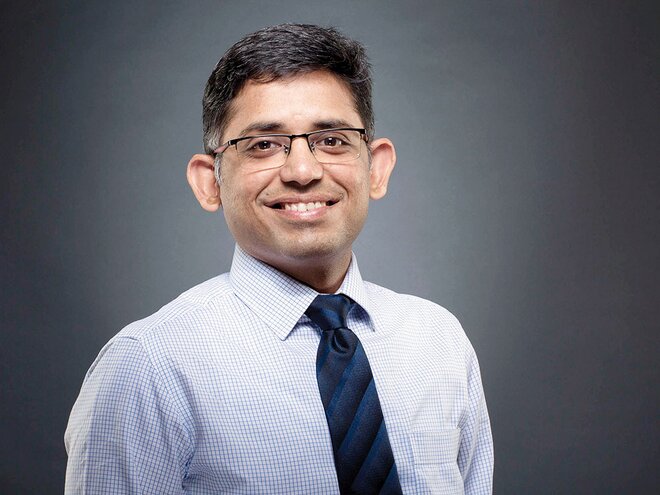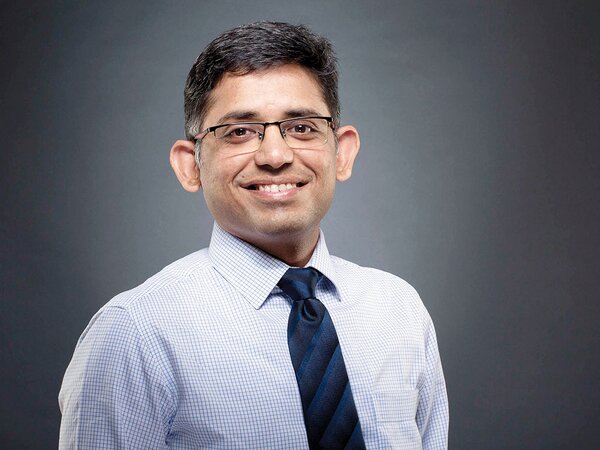
After the crash in March, the stock market has smartly recovered. This has baffled investors. Moreover, mid and small caps have rallied over the last three months, which has attracted investors' attention. We speak to Vinit Sambre, who suggests that the rally is not in sync with the fundamentals. Sambre has also taken over the responsibility of DSP Top 100 Equity Fund, a large-cap scheme. Until now, he has managed mid- and small-cap schemes. We ask him about his strategy for managing a large-cap scheme now. He also talks about why he is betting on beaten down sectors and about the outstanding performance of DSP Quant Fund.
What are your views on the way markets have reacted after the short-lived crash in March? Does this disconnect between the grim economic reality and a sharp market recovery baffle you?
I do think that the markets seem to have lost the correlation with what is happening on the economic front currently. But this type of movement is generally short-lived and has happened in the past as well. As it is popularly said, the markets can remain irrational longer than one can remain solvent.
This exuberance or irrationality in the market, given the economic environment, is certainly challenging. But what's noteworthy is that we're facing an external issue which I don't think anyone has faced ever. It seems people have different views on what its outcomes can be. People tend to look at incremental news. After March and April, May was slighter, and June was better still. Moreover, most governments are providing stimulus to their economies, which is also contributing to the market rally. I think another factor at play is that in the lockdown period, retail participation has gone up and that is also adding to the current momentum.
However, these things don't impact our long-term thought process. We are trying to have a rational view on how companies are dealing with the current situation. We are trying to identify businesses which are better placed or are more resilient in the current scenario.
You talked about the exuberance factor in the market. Is that contributing to elevated cash levels in your portfolios?
Yes, you are right. We constantly try to identify good businesses while being cautious of the valuations at which we want to buy them. If a set of targeted companies is beyond our comfort zone on valuations, we don't mind waiting and that leads to accumulation of cash. In the current environment, we are high on cash as we wait for an opportunity to deploy the same.
The markets are possibly not factoring in most of the potential negatives going forward. So it makes sense to be in cash and try to deploy it during periods of volatility, which we foresee in the next two or three quarters. In case there isn't any correction and recovery keeps happening, we will start deploying the cash gradually, taking into consideration the new economic factors.
You've sounded cautious on valuations since 2017, when DSP Small Cap (called DSP BlackRock Micro Cap back then) put gates on inflows. Even in June 2019, you described the valuations for small caps as only 'slightly less expensive'. What's your view now? Fresh and perhaps bigger concerns have emerged on the denominator side of valuation ratios
Yes, I've been more conservative as we have observed hyperactivity in the mid- and small-cap space for the past three years now. And these categories have been underperforming.
But before COVID happened, there was a phase when mid caps and small caps started trading at a discount to large caps. And we started debating whether we are at a good point in the cycle to open the small-cap fund for inflows. Sometime around November or December last year, we started believing that we should be in a position to deploy fresh inflows as some of the stocks had corrected. But we still decided to wait. And then COVID happened in March and the markets crashed. That's when we said that while the economic environment looks challenging and may remain so for six months to one year, we don't mind that actually since our philosophy is to buy and hold for two to five years. So, we took the decision to open our small-cap fund for inflows.
The way to look at the current situation is that we are in a down cycle. The earnings are at a cyclical low. Valuations from that standpoint look a bit punchy. But if one is willing to accumulate and hold through this low cycle, I think small caps make a good case.
The business environment may remain extremely difficult for a fair while, more so for many small companies. What are your key concerns as an investment manager active in this segment of the market?
One thing that remains constant to our philosophy is to weed out companies which start showing signs of wrong capital allocation or any corporate-governance issues or any major regulatory bottleneck which is going to have a long-term bearing on the business. These form the core investment philosophy, irrespective of whether we are in good times or passing through a challenging phase such as this one. It works as a good checklist of what we clearly want to eliminate.
Now as far as the current scenario is concerned, we are not worried about issues such as the possibility of a liquidity crunch, balance-sheet issues or high leverage, etc. Given our investment philosophy, we are pretty confident on those aspects. We are trying to analyse how long each business can take to normalise but we don't want to react too soon.
You are going against the herd on quite a few sectors, as reflected in your underweight positions in FMCG and optimism on auto ancillaries and textiles. What's your thinking behind these positions?
I like businesses which are compounders and FMCG generally fits that basket. But we are also conscious of valuations. I try to correlate them with the earnings cycle. In the case of FMCG, the growth rates had started tapering off even before COVID but the valuations were only getting richer and richer. So there was a total disconnect between the fundamentals and the valuations. We don't want to go with the herd in such cases but wait instead.
Also, businesses have their own cycles. So if a sector is undergoing a bad phase, it doesn't necessarily mean that all companies in that sector are not expected to perform well. For example, in 2016, the pharma sector hit a rough patch and the stock prices of pharma companies crashed but not all companies in the sector were facing issues, providing us a great opportunity to move in.
Auto ancillary is another classic example. If you map the 25-30-year history of car and two-wheeler sales, you would realise that the sector has historically shown strong growth followed by one to two years of bad patch. So we said that one year of underperformance creates a low base. And if you pick up any two-wheeler companies and look at the cash flow generation, the ROCE and other metrics, I think they are phenomenal. So we thought let's pick businesses linked to the auto cycle which are being ignored right now. When the cycle turns, these companies will grow significantly and when others start buying, we will probably be selling.
Your small-cap fund is among the top five based on AUM but it ranks among the bottom ones on average market cap of the underlying portfolio. Does this gap between the size of the fund and the size of the companies it invests in pose any challenges? What about liquidity?
When I took over the fund, I had the freedom to invest about 35 per cent of assets in large caps. However, I refrained from doing so as I wanted it to be true to label. I'm a person with a core belief that there are good small companies with good managements. And they do wonderfully well to let investors participate in their journey from being small to becoming big, really big. I didn't want to dilute this belief. We were okay holding mid caps to some extent but principally we avoided large caps.
As for liquidity, let me provide some historical perspective. This fund was launched as a closed-end fund in 2007. It was only in 2010 that it became open-end. And while we were turning this to an open-end fund, we were expecting large redemptions. After the Lehman crisis, people had seen its NAV drop from Rs 10 to Rs 4, a 60 per cent fall. Though it had recovered well to around Rs 14-15 by the time it was made open-end, after a big fall, people tend to take their money and leave at the first opportunity. I had maintained some cash levels in the portfolio at that time but we didn't face much redemption.
On an ongoing basis, the way we have approached this issue is to be invested in solid companies so that even if we are ever forced to sell at discounted prices for some reason, there are buyers available. Second is to have a decent mix of mid caps, which are better placed in terms of liquidity. And generally, the cash allocation in the portfolio has also gone up from about 2-3 per cent (when it was Rs 300-500 crore in size) to 5-6 per cent as a rule.
Now if there is ever a big run down, a very big problem that nudges everyone to take money out of small caps, then the whole category will have an issue. Otherwise, we should be fine.
You've recently taken over the management of DSP Top 100 Equity, your AMC's large-cap fund. That's a strategy you've not managed earlier in your fund-management career. Tell us about your approach to generate alpha here and your immediate focus areas as you embark on putting its performance back on track.
I think the fundamental rules remain the same. If you can identify businesses that can grow at a rate higher than that of the peers because of their competitive advantage, have good management and keep a close watch on how they utilise their capital, they will tend to create value, whatever capitalisation range that may be.
Over and above that, we will add a layer of sectoral view for the largecap fund. And if we have strong conviction on any company or sector, we would not shy away from taking large active bets. If you look at the index, it has outperformed because of polarisation. So, if a few good companies are able to do well, we are going to use our skill to try and capture that.
Given the current environment, we have set the ball rolling by getting some defensive stance to the portfolio. So we have reduced the weightage of financials and increased exposure to some defensive sectors. We have also consolidated the portfolio to an extent by exiting some stocks.
DSP Quant Fund, your model-driven offering, has outperformed the other DSP diversified equity funds over the last one year. How do you see this with respect to quant strategies emerging as a substitute for conventional fund management? On a lighter note, does that make you nervous?
(Laughs out loud) No! No! In fact, it's good to see it performing so well! We were all part of this project when the rules were getting designed. It was a collective effort. And we would really like it to be called a rules-based fund instead of a quant fund. I would say that if my rules-based fund tomorrow becomes the largest fund, I'd be very happy.
I believe that for any product, if you are working in a much-disciplined manner and are really walking the talk by being true to your core philosophy, over time, investors will realise the merit of that. That's where the rules-based fund has an advantage - you are able to do better 'visibly'. Otherwise, you tell me in any fund what visibility does one have beyond the back-dated performance data? Instead, if one is able to get more insight into the inputs, what a fund is trying to apply and put into action, it helps investors have a clearer understanding of what the fund would do with their money. My rules-based fund has these well-documented and the people who like that will come there. It gives investors the confidence to invest.



__w1000__h564__.jpg)





